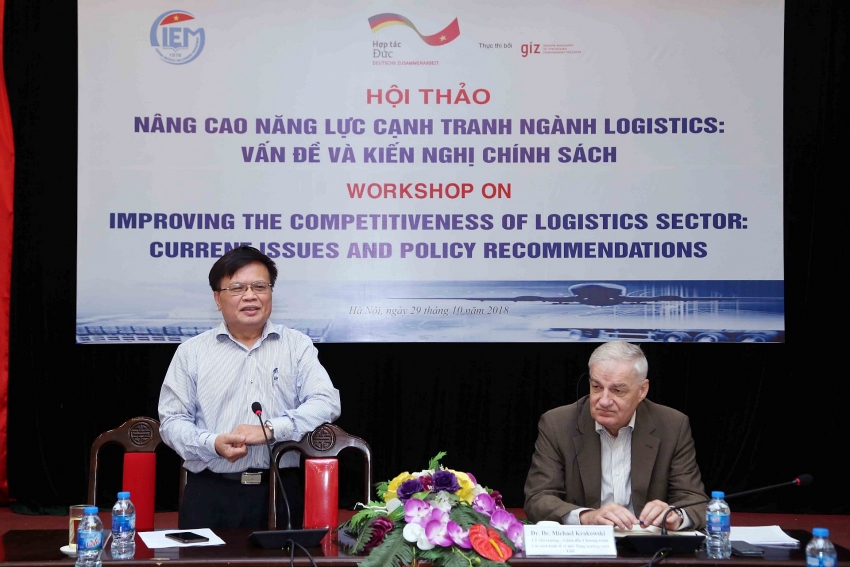Improving competitiveness of the Vietnamese logistics sector
 |
| Nguyen Dinh Cung and Michael Krakowski co-chairing the workshop |
On October 29, 2018, the Central Institute for Economic Management (CIEM) held a workshop on current issues and policy recommendations to improve the competitiveness of the logistics sector. The workshop was an opportunity to discuss the situation of Vietnam’s logistics sector, point out difficulties, and propose solutions and policies for the perfection of the legal system surrounding logistics, as well as develop logistics services along with the reduction of costs and improvement of enterprises’ competitiveness.
At the workshop, CIEM president Nguyen Dinh Cung said that logistics is core of international trade. Low-cost logistics services will match clients’ demands and strengthen the development of trade activities and the national economy. The good performance of the logistics sector could contribute 1 per cent to the GDP and 2 per cent to trade turnover. Thereby, this sector needs to be changed to meet the development needs of the market and the economy.
Michael Krakowski, director of GIZ’s Macroeconomic Reform Programme and Green Growth, said that it is necessary to create policies across each sector to specifically take advantage of Industry 4.0, as well as set out solutions for each sector. Logistics is one such solution.
In 2018, hundreds of legal documents have been issued, so the performance of this sector has been improved. Vietnam’s cross-border trading was ranked by the World Bank as 94th out of 190 economies, which enabling the country to rank 73rd from 136 economies on the 2016 trade index of World Economic Forum (WEF), while the World Bank’s 2018 logistics performance index (LPI) put Vietnam 39th out of 160 countries, a significant improvement from 64th two years ago. LPI reported that Vietnam’s logistics performance is better than other same-income markets.
However, according to CIEM, costs are still high and clearance take far too long. Meanwhile, the development of logistics infrastructure is not synchronous and connected. Shipping, which accounts for 60 per cent of the market share, belongs mostly to international shipping lines. Foreign logistics companies capture 3 per cent of the volume, but make up 80 per cent of the revenue of the Vietnamese logistics sector, while most domestic firms are small, specialising in simple services as the satellites of foreign firms. Business registration and administrative procedures remain large obstacles, while the efficiency of transport/freight trading platforms is relatively low.
 |
| Nguyen Minh Thao, head of CIEM's Business Environment and Competitiveness |
Nguyen Minh Thao, head of CIEM's Business Environment and Competitiveness, outlined some trends in the logistics sector, such as robotics, automation, and Internet of Things (IoT), which help handling and classifying Amazon's goods, in addition to anticipatory shipping, Virtual Reality (VR), and augmented reality (AR), which are applied by DHL Express, and artificial intelligence (AI).
Technical solutions could be applied in every segment of the logistics chain, for example, self-driving cars, routing system, transport/freight trading platforms in road transport; using robotics, automation software, and barcodes in the management of warehouses; as well as applying drones and droids in last mile delivery.
Therefore, the CIEM researcher proposed several solutions to strengthen technology applications in this sector, including building policies, boosting the linkages between e-commerce and logistics. In order to reduce costs and improve the competitiveness of the logistics sector, he suggested to review roads and bridges, develop containers and trucks parking areas, cut 50 per cent of business conditions and 50 per cent of must-check items, as well as enhance the effectiveness of transport/freight trading platforms.
What the stars mean:
★ Poor ★ ★ Promising ★★★ Good ★★★★ Very good ★★★★★ Exceptional
 Tag:
Tag:
Related Contents
Latest News
More News
- Ho Chi Minh City hits $8.37 billion in FDI (December 29, 2025 | 08:28)
- Tax sector wraps up 2025 and sets priorities for next year (December 25, 2025 | 14:00)
- Heavy industries set for pilot greenhouse gas quotas (December 25, 2025 | 10:00)
- $250 million deal targets women-owned SMEs, sustainable agriculture (December 22, 2025 | 17:40)
- UOB sees Vietnam growth easing in fourth quarter (December 22, 2025 | 17:39)
- Government moves to establish International Financial Centre (December 21, 2025 | 21:00)
- Vietnam's IFC to target global investment flows (December 21, 2025 | 18:00)
- Ha Tinh breaks ground on major Vingroup industrial and energy projects (December 19, 2025 | 18:24)
- EVN launches major power infrastructure projects nationwide (December 19, 2025 | 18:17)
- VAL inaugurates second production line to meet domestic animal feed demand (December 19, 2025 | 16:37)





























 Mobile Version
Mobile Version